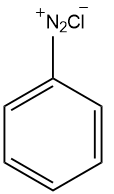
Benzene diazonium chloride on hydrolysis gives:
(A)Benzene
(B)Benzyl Alcohol
(C)Phenol
(D)Chlorobenzene
Answer
578.4k+ views
Hint: Diazonium compounds or diazonium salts are a group of organic compounds sharing a common functional group, $R-{{N}_{2}}^{+}{{X}^{-}}$, where R can be any organic group. Many diazonium salts are susceptible to displacement reactions by various substrates, generating nitrogen as a by-product.
Complete step by step solution:
Benzene diazonium chloride is an organic compound with the formula $({{C}_{6}}{{H}_{5}}{{N}_{2}})Cl$. The structure of Benzene diazonium chloride is as follows:

It is a salt of a diazonium cation and chloride. It exists as a colourless solid that is soluble in polar solvents including water. Benzene diazonium chloride can be formed by first mixing benzene with nitric acid, which forms nitrobenzene. Nitrobenzene can then be transformed into aniline and aniline can be mixed with nitrous acid in the presence of hydrochloric acid to form the benzene diazonium chloride molecule. During the preparation of Benzene diazonium chloride, lower temperatures are favoured it because the formed Benzene diazonium chloride will become unstable if the temperature becomes more than ${{5}^{\circ }}C$
-On hydrolysis of Benzene diazonium chloride, Nitrogen molecules escape as nitrogen gas. The OH group of water attacks the vacant site left after removal of nitrogen gas. This results in the formation of phenol. Also, Small amount of NaCl is also generated.

Therefore, the correct answer is (C) option.
Note: Another common pathway is to undergo a coupling reaction to form a diazo compound. Diazonium salts are important synthetic intermediates that can undergo coupling reactions to form azo dyes and electrophilic substitution reactions to introduce functional groups.
Complete step by step solution:
Benzene diazonium chloride is an organic compound with the formula $({{C}_{6}}{{H}_{5}}{{N}_{2}})Cl$. The structure of Benzene diazonium chloride is as follows:

It is a salt of a diazonium cation and chloride. It exists as a colourless solid that is soluble in polar solvents including water. Benzene diazonium chloride can be formed by first mixing benzene with nitric acid, which forms nitrobenzene. Nitrobenzene can then be transformed into aniline and aniline can be mixed with nitrous acid in the presence of hydrochloric acid to form the benzene diazonium chloride molecule. During the preparation of Benzene diazonium chloride, lower temperatures are favoured it because the formed Benzene diazonium chloride will become unstable if the temperature becomes more than ${{5}^{\circ }}C$
-On hydrolysis of Benzene diazonium chloride, Nitrogen molecules escape as nitrogen gas. The OH group of water attacks the vacant site left after removal of nitrogen gas. This results in the formation of phenol. Also, Small amount of NaCl is also generated.

Therefore, the correct answer is (C) option.
Note: Another common pathway is to undergo a coupling reaction to form a diazo compound. Diazonium salts are important synthetic intermediates that can undergo coupling reactions to form azo dyes and electrophilic substitution reactions to introduce functional groups.
Recently Updated Pages
The number of solutions in x in 02pi for which sqrt class 12 maths CBSE

Write any two methods of preparation of phenol Give class 12 chemistry CBSE

Differentiate between action potential and resting class 12 biology CBSE

Two plane mirrors arranged at right angles to each class 12 physics CBSE

Which of the following molecules is are chiral A I class 12 chemistry CBSE

Name different types of neurons and give one function class 12 biology CBSE

Trending doubts
Which are the Top 10 Largest Countries of the World?

What are the major means of transport Explain each class 12 social science CBSE

Draw a labelled sketch of the human eye class 12 physics CBSE

Differentiate between insitu conservation and exsitu class 12 biology CBSE

The computer jargonwwww stands for Aworld wide web class 12 physics CBSE

State the principle of an ac generator and explain class 12 physics CBSE




